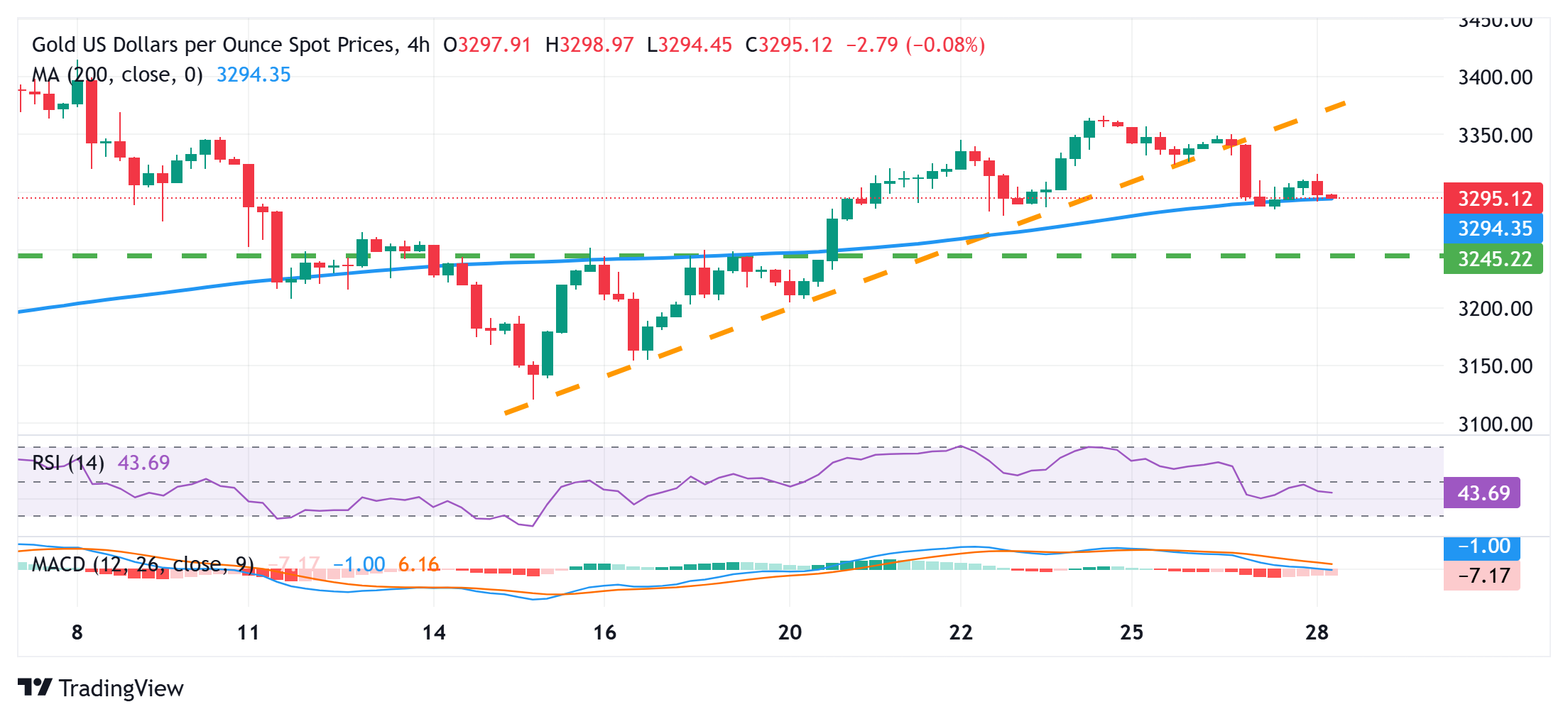-
Gold price edges higher as cautious trading, U.S. fiscal worries, and geopolitical tensions support demand for safe-haven assets.
-
Continued USD strength and a generally positive risk sentiment limit further upside for XAU/USD.
-
Investors await the FOMC Minutes for clearer guidance on the rate-cut outlook before making new directional moves.
Gold price (XAU/USD) builds on modest intraday gains, climbing to a new daily high around the $3,323–3,324 range during early European trading. Despite recent trade optimism, investor sentiment remains cautious due to lingering uncertainty over U.S. trade tariffs under President Donald Trump, ongoing fiscal concerns, and persistent geopolitical risks—factors that continue to drive demand for the safe-haven metal.
At the same time, the US Dollar (USD) struggles to maintain its modest gains amid growing concerns over the deteriorating fiscal outlook in the U.S. Additionally, expectations of another interest rate cut by the Federal Reserve keep USD bulls on the sidelines, providing further support to XAU/USD. However, traders remain cautious and prefer to await the release of the FOMC Minutes before committing to new positions.
Daily Digest Market Movers: Gold Price Supported by Intraday Safe-Haven Demand
- Gold price continues to attract intraday safe-haven flows as market sentiment remains fragile amid a mix of economic data and geopolitical developments.
- The US Census Bureau reported a 6.3% drop in Durable Goods Orders for April, a sharp reversal from March’s upwardly revised 7.6% increase (previously 9.2%). While the decline was significant, it was still better than market expectations of a 7.9% fall. Additionally, core orders excluding transportation rose by 0.2%, indicating some resilience in underlying demand.
- Meanwhile, the Conference Board’s Consumer Confidence Index surged to 98 in May from 85.7 in April, marking the largest monthly jump in four years. The rebound reflects growing optimism about the economy and labor market, fueled by a recent US-China trade truce, which in turn supported the US Dollar.
- In a move that eased some market tension, President Donald Trump postponed the proposed 50% tariffs on the European Union from June 1 to July 9. This decision offered temporary relief but did little to dispel broader concerns over persistent US-China trade frictions, a worsening US fiscal outlook, and heightened geopolitical risks—factors that continue to support gold’s safe-haven appeal.
- Market participants are now pricing in at least two 25 basis point rate cuts from the Federal Reserve in 2025. These expectations are bolstered by signs of cooling inflation and concerns that Trump’s proposed “Big, Beautiful Bill”—if passed—could accelerate the deterioration of the US budget deficit, limiting the upside for the US Dollar.
- On the geopolitical front, tensions remain elevated. President Trump accused Russian President Vladimir Putin of “playing with fire” by refusing to enter ceasefire negotiations with Ukraine, following the deadliest Russian drone and missile attacks since the 2022 invasion. Meanwhile, an Israeli official denied claims that Hamas had accepted a new US-backed ceasefire deal for Gaza.
- Looking ahead, traders await the FOMC meeting minutes for guidance on the Fed’s future rate-cut trajectory. The outcome will be crucial for the direction of the US Dollar and gold. Investors will also keep an eye on the upcoming US Q1 GDP preliminary data and the PCE Price Index, scheduled for release on Thursday and Friday, respectively.
Gold Price Rebounds from 200-SMA Support on H4 Chart, But Bearish Risks Remain
From a technical standpoint, the recent breakdown below a short-term ascending trend line acted as a bearish trigger, inviting selling pressure. A sustained move below the 200-period Simple Moving Average (SMA) on the 4-hour chart and continued weakness under the $3,300 level would reinforce the negative bias. That said, daily chart oscillators—while showing signs of losing momentum—have not yet confirmed a fully bearish outlook. As a result, any further decline may attract dip-buying interest, with strong support expected near the $3,250–$3,245 horizontal zone. A decisive break below this area would open the door for a deeper near-term correction in gold.
On the upside, any recovery could face initial resistance in the $3,340–$3,345 region, aligning with the broken trend line. A break above this level could trigger a round of short-covering, potentially lifting gold toward the recent two-week high near $3,365–$3,366, last seen on Friday. Sustained strength beyond this zone would be a bullish signal and could pave the way for a climb toward the psychological $3,400 level, with the next key resistance seen around $3,465–$3,470.






